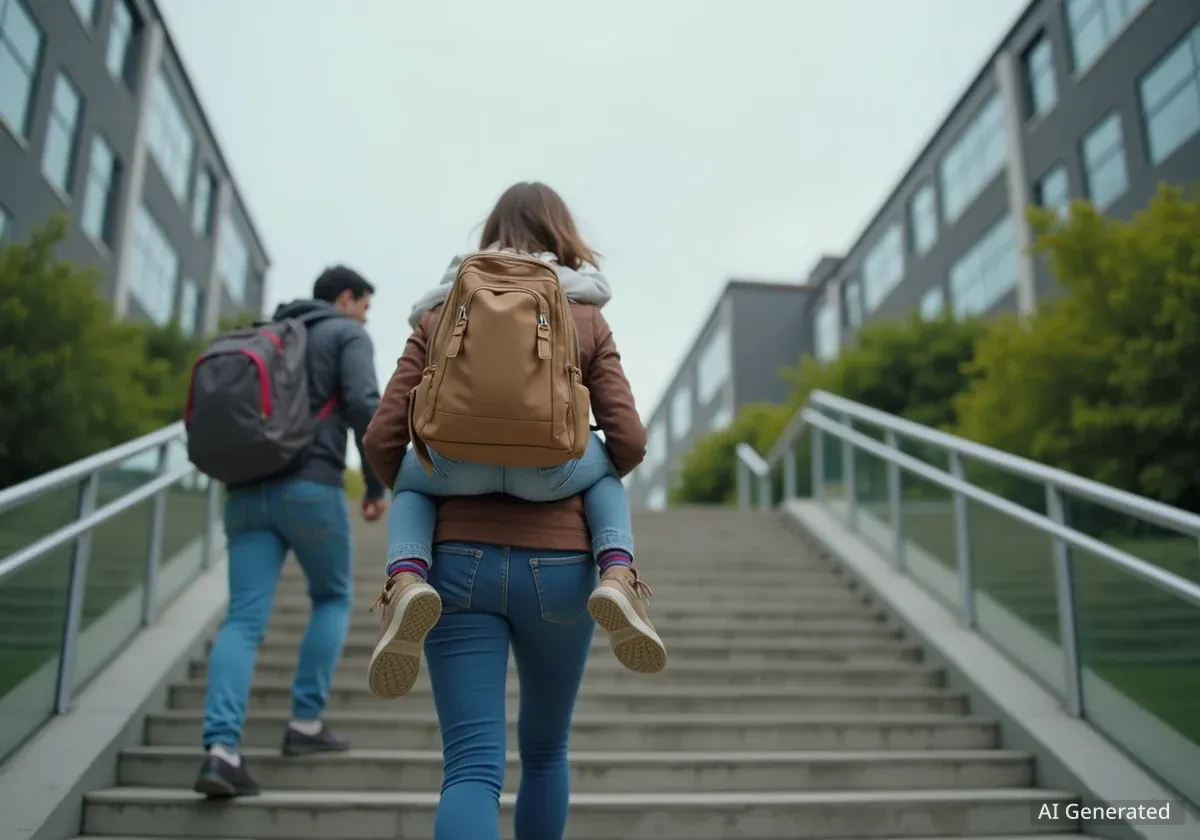In Washington's Puget Sound region, a significant number of college students are also parents, facing the dual challenge of pursuing higher education while securing reliable child care. For these students, access to on-campus facilities can be the deciding factor in their ability to attend classes and complete their degrees.
At Pierce College in Puyallup, the Garnero Child Development Center provides a vital service for student parents like 25-year-old Bailey Hazzard. This center is one of approximately 20 similar facilities located on community and technical college campuses across the state, highlighting a critical but limited support system for a growing student demographic.
Key Takeaways
- Student parents represent a substantial portion of the undergraduate population, often facing unique obstacles to completing their education.
- A lack of affordable and accessible child care is a primary barrier that can hinder academic progress and lead to students dropping out.
- Washington state has about 20 on-campus child care centers at its community and technical colleges, serving as a lifeline for students.
- These centers offer convenience and peace of mind, allowing parents to focus on their studies while their children are cared for nearby.
The Daily Reality for Student Parents
For many students balancing parenthood and academics, the day is a carefully managed schedule of classes, study time, and child-rearing responsibilities. Bailey Hazzard's situation at Pierce College illustrates the benefits of integrated support systems. Her toddler, Finnley, attends the on-campus child care center, allowing both parent and child to be at the same location.
This arrangement eliminates the logistical hurdles of commuting between a separate daycare and the college campus. It provides a structured, educational environment for the child while giving the parent the focused time needed to succeed in their coursework. The proximity offers peace of mind, knowing their child is just a short walk away.
However, this convenience is not available to all. The limited number of on-campus centers means many student parents across the state must piece together alternative, often more expensive and less convenient, child care solutions. This can involve relying on family members, navigating subsidized programs with long waitlists, or paying high market rates that strain an already tight student budget.
A National Trend
The challenge faced by student parents is not unique to Washington. According to data from the Institute for Women's Policy Research, approximately 22 percent of all undergraduate students in the United States are parents. This demographic is more likely to be low-income and face time constraints that make completing a degree more difficult than for their non-parenting peers.
Washington's On-Campus Child Care Network
The network of roughly 20 child care centers on Washington's community and technical college campuses represents a significant investment in student success. These facilities are specifically designed to meet the needs of the college community. For example, the Garnero Child Development Center at Pierce College’s Puyallup campus is staffed by professionals like teacher Alaura Michaelson and assistant teacher Rased Aws, who provide care and early education.
These centers do more than just supervise children; they offer developmental programs that prepare young children for school. By providing high-quality care, colleges are not only supporting their current students but also investing in the next generation. This dual benefit underscores the importance of such programs.
The Impact of Accessible Care
The presence of an on-campus child care center can directly influence a student's ability to persist in their studies. Research has shown that student parents who have access to reliable child care have higher rates of course completion and are more likely to graduate.
The benefits extend beyond academics. Having a support system in place reduces parental stress, allowing students to better engage in campus life and focus on their long-term career goals. It transforms the college experience from a constant struggle to a manageable and rewarding journey.
Statistics on Student Parent Success
- Student parents often take longer to graduate than non-parents, largely due to competing demands on their time and finances.
- Access to affordable child care has been shown to improve graduation rates for single-mother students by a significant margin.
- Graduation not only improves the parent's economic future but also has a positive multi-generational impact on their children's outcomes.
Overcoming the Remaining Hurdles
While on-campus centers are highly effective, they are not a complete solution. Many of these programs face significant challenges, including funding limitations, staffing shortages, and long waiting lists. The demand for spots often far exceeds the available capacity, leaving many student parents without support.
Furthermore, the cost of care, even when subsidized, can still be a burden for students living on a limited income. Financial aid packages do not always account for the full cost of child care, creating a gap that students must fill themselves. This financial pressure can force students to reduce their course load, prolonging their time to graduation, or even drop out entirely.
Advocates argue that greater public and institutional investment is needed to expand these vital services. Expanding the number of available spots, increasing financial assistance for student parents, and ensuring stable funding for campus centers are seen as crucial steps toward improving educational equity.
A Pathway to Economic Mobility
Supporting student parents is ultimately an investment in the state's workforce and economy. When a parent earns a college degree, they significantly increase their earning potential, reducing their reliance on public assistance and contributing more to the tax base. Their success provides a powerful example for their children and helps break cycles of intergenerational poverty.
Institutions like Pierce College that provide on-campus child care are creating pathways to opportunity. By addressing one of the most significant barriers to education, they empower parents to build a better future for themselves and their families. As the number of students juggling school and parenting continues to grow, the need for comprehensive support systems will only become more urgent.





